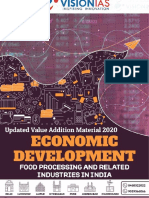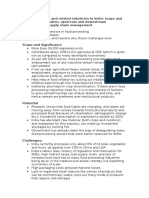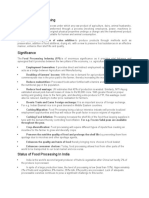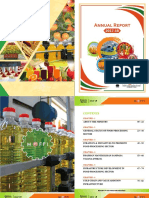SIMPERION IAS
Food Processing and Related Industries in India- Scope and Significance,
Location, Upstream and Downstream Requirements, Supply Chain
Management
The food processing industry involves the transformation of raw ingredients into food
products suitable for consumption. This industry encompasses various processes such as
cleaning, sorting, milling, mixing, cooking, packaging, and preservation to enhance the shelf
life, flavour, and nutritional value of food.
✓ 1970s: Establishment of the National Dairy Development Board (NDDB) and
Operation Flood to enhance milk production and processing.
✓ 1998: Establishment of the Ministry of Food Processing Industries (MoFPI) to
promote and regulate the sector.
✓ Department of Animal Husbandry, Dairying & Fisheries (DAHD&F) Part of the
Ministry of Fisheries, Animal Husbandry and Dairying. Promotes and regulates
animal husbandry, dairy farming, and fisheries
Facts About Food Processing in India
1. Economic Impact: Food processing industry contributes 10-11% to manufacturing
GDP.
2. Employment: Food processing industry employs 1.77 million people.
3. Growth Rate: Food processing industry average annual growth of 8.4% over five years.
4. Market Size: Food processing industry market size expected to reach USD 535 billion
by 2025.
5. Exports: Processed food exports valued at USD 30 billion in 2020-21
6. India is the world's second-largest producer of fruits and vegetables, after China. India
process only 2% of produce.
7. Low Processing: Approximately 2% of fruits and vegetables, 8% marine, 35% milk, 6%
poultry are processed
8. More than 75% of the industry is in unorganized sector.
https://t.me/UpscmainsGS2024
� SIMPERION IAS
Key Drivers of the Food Processing Industry in India
1. Second Largest Producer of Fruits & Vegetables: 14% of global production.
2. Major Player in Marine Products & Meat/Poultry
3. World's Largest Milk Producer: 22% of global production.
4. Largest Livestock Population: 535.78 million livestock (2019).
5. Significant Contributor to GDP: 17.8% of GDP (2019-20).
6. Growing Urbanization: 600 million urban population by 2031; higher demand for
processed foods.
7. Rising Disposable Income: Per capita income: ₹1,72,000 (2022-23); more spending on
packaged foods.
8. Changing Dietary Patterns
9. Government Support for food processing Industry
10.Export Potential: Processed food exports: USD 30 billion (2020-21); target USD 60
billion by 2022.
https://t.me/UpscmainsGS2024
� SIMPERION IAS
Significance of the Food Processing Industry (FPI) in India
1. Sunrise Industry: Vital link between agriculture and industry.
2. Employment Generation: Creates millions of jobs, especially in rural areas.
3. Demographic Dividend: Leverages young workforce for growth and innovation.
4. Curbing Migration: Provides rural employment, reducing urban migration.
5. Increasing Farmers' Income: Adds value to produce, enhancing farmers' earnings.
6. Reduces Food Wastage: Addresses 25-35% food wastage due to handling and storage
issues.
7. Curbing Food Inflation: Increases shelf life, stabilizing food prices.
8. Forward-Backward Linkages: Strengthens agricultural value chain, boosting
productivity and sustainability.
https://t.me/UpscmainsGS2024
� SIMPERION IAS
Scope of Food Processing in India
1. India's Agricultural Prowess:
o Second-largest producer of fruits, vegetables, rice, wheat, potatoes, sugarcane,
and tea.
o Diverse agro-climatic conditions support various crops year-round.
2. Increasing Opportunities for Allied Sectors:
o Growth in dairy, meat, poultry, and fisheries processing.
3. Resource-Rich India:
o Vast availability of raw materials for processing.
o Leading producer of milk, fruits, and vegetables globally.
4. Global Rankings:
o India is a top producer in several agricultural commodities.
o Significant presence in global markets for spices, tea, and seafood.
5. Growing Urbanization and Market:
o Urban population expected to reach 600 million by 2031.
o Increasing demand for processed and convenience foods. India’s food market
ranks fifth globally in production, consumption, and exports.
https://t.me/UpscmainsGS2024
� SIMPERION IAS
Challenges in the Development of Food Processing Industry
1. Infrastructure Deficiencies:
o Inadequate cold storage and transport facilities cause 25-30% post-harvest
losses.
2. Regulatory Hurdles:
o Complex regulations lead to compliance costs; India ranks 63rd in Ease of
Doing Business (2020).
3. Fragmented Supply Chain:
o Only 10% of agricultural produce reaches processing units directly.
4. Quality and Safety Standards:
o 70% of food processing units are unorganized, leading to inconsistent quality.
5. Limited Access to Technology:
o 85% of food processing units are small-scale industries with limited
technological adoption.
6. Skilled Workforce Shortage:
o Only 2% of the workforce is formally trained in the food processing sector.
7. High Processing Costs:
o High costs of raw materials and energy contribute to 18-20% higher
production costs.
8. Financial Constraints:
o Only 3% of total bank credit is allocated to the food processing sector.
9. Seasonal Raw Material Supply:
o Seasonal variability leads to irregular supply and affects production
consistency
Measures Needed for the Development of Food Processing Industries
1. Infrastructure Improvement: Invest in cold storage and transport facilities.
2. Regulatory Simplification: Streamline and simplify food processing regulations.
3. Supply Chain Integration: Develop direct farmer-processor linkages.
4. Technological Upgradation: Facilitate access to modern processing technologies.
5. Skill Development: Increase training programs and vocational courses.
6. Financial Support: Enhance credit availability and financial assistance
https://t.me/UpscmainsGS2024
� SIMPERION IAS
Government Initiative to Promote the Food Processing Sector
1. Pradhan Mantri Kisan Sampada Yojana (PMKSY):
o ₹6,000 crore for infrastructure and value chain development.
2. Mega Food Parks Scheme:
o Establish state-of-the-art processing facilities.
3. Cold Chain Infrastructure:
o Financial support for cold storage and transport.
4. Operation Greens:
o Stabilize prices of tomatoes, onions, and potatoes.
5. Food Safety and Standards Authority of India (FSSAI):
o Enforce food safety regulations.
6. Agro-Processing Cluster Scheme:
o Create clusters with modern processing infrastructure.
7. Dairy Processing and Infrastructure Development Fund (DIDF):
o Financial support for dairy infrastructure and modernization.
National Food Processing Policy 2019
Promote Investment + Enhance Infrastructure + Increase Farmer Income + Reduce Wastage +
Ensure Food Safety + Boost Exports + Employment Generation + Support SMEs + Foster
Innovation +Sustainable Practices
Supply Chain Management (SCM)
Supply Chain Management (SCM) coordinates the flow of goods, information, and
finances from suppliers to consumers. It involves sourcing, procurement, production, and
logistics to ensure timely delivery of products in the right quantities.
https://t.me/UpscmainsGS2024
� SIMPERION IAS
Upstream Supply Chain Management
Upstream Supply Chain Management involves the procurement and sourcing of raw materials needed for
production. It focuses on managing supplier relationships and ensuring timely delivery of inputs.
Key Activities:
1. Sourcing and Procurement: Acquiring raw materials from suppliers.
2. Supplier Relationships: Building and maintaining supplier partnerships.
3. Inbound Logistics: Managing transportation and storage of raw materials.
Downstream Supply Chain Management
Downstream Supply Chain Management involves the distribution and delivery of finished products to
customers. It ensures efficient market reach and meeting customer demand.
Key Activities:
1. Distribution and Logistics: Transporting and delivering finished products.
2. Customer Relationships: Managing interactions with customers.
3. Sales and Marketing: Promoting and selling products to end-users.
Importance of Supply Chain Management for India
1. Economic Growth: Enhances efficiency and productivity, boosting GDP.
2. Cost Reduction: Minimizes production and logistics costs.
3. Improved Customer Satisfaction: Ensures timely product delivery and enhances experience.
4. Boosts Competitiveness: Enables companies to compete globally.
5. Reduces Waste: Promotes sustainability by minimizing wastage.
https://t.me/UpscmainsGS2024
� SIMPERION IAS
Challenges to Supply Chain Management
1. Fragmented Supply Chain:
o Causes wastage and price escalations.
2. Inadequate Cold Storage and Warehousing:
o Only 20% warehousing is organized, leading to 30% wastage.
3. Logistics Issues:
o Poor infrastructure; highways carry 40% of cargo but are only 2% of the road network.
4. Slowdown in Production Growth:
o 67% landholdings are marginal, averaging 0.4 hectares.
5. Large Informalization:
o 50% of food processing units are unorganized.
Supply Chain Resilience
Supply Chain Resilience refers to the ability of a supply chain to prepare for, respond to, and recover from
disruptions to ensure continuous operations and meet customer demand.
Key Points:
1. Adapt quickly to changes and disruptions in the supply chain environment.
2. Reduce dependency on single sources by having multiple suppliers.
3. Implement strategies to identify, assess, and mitigate potential risks.
4. Utilize technologies like AI, IoT, and blockchain for real-time monitoring and
decision-making.
5. Foster open communication and collaboration among all supply chain partners.
https://t.me/UpscmainsGS2024
� SIMPERION IAS
Measures for Better Supply Chain Management
1. Adopt Advanced Technologies:
o Use AI and blockchain for real-time tracking.
2. Develop Robust Infrastructure:
o Invest in cold storage and efficient warehousing.
3. Strengthen Supplier Networks:
o Diversify and build strong supplier relationships.
4. Streamline Logistics:
o Optimize transportation and delivery processes.
5. Implement Risk Management:
o Develop and execute contingency plans for disruptions.
e-NAM (National Agriculture Market): Provides a unified national market for
agricultural commodities to streamline supply chains in agriculture.
The Mega Food Park Scheme, initiated by the Indian government, aims to provide a
mechanism to link agricultural production to the market by bringing together farmers,
processors, and retailers to ensure maximizing value addition, minimizing wastage, increasing
farmers' income, and creating employment opportunities.
✓ Value Addition: Enhance food processing and reduce wastage.
✓ Infrastructure Development: Create advanced food processing facilities.
✓ Farmers' Income: Improve market access and reduce intermediaries for farmers.
✓ Employment Generation: Create rural jobs in food processing.
✓ Export Promotion: Boost exports of processed food with quality standards.
Launched in 2008, the Mega Food Park Scheme aims to enhance food processing
infrastructure and market access. However, by 2023, only 23 out of 42 approved
projects are operational, showing limited progress.
In Netherlands and USA 60-70% of agriculture out is processed.
https://t.me/UpscmainsGS2024
� SIMPERION IAS
Impediments in Marketing and Supply Chain Management:
1. Poor Infrastructure: Inadequate roads and warehouses delay deliveries. Example:
Farmers in Bihar struggle to get produce to markets due to poor road conditions.
2. Logistical Bottlenecks: Inefficient transportation networks cause frequent delays.
Example: Trucking delays in Maharashtra lead to spoilage of perishable goods.
3. Fragmented Markets: Diverse regional markets complicate unified strategies.
Example: FMCG companies face challenges in marketing products differently in
Tamil Nadu and Punjab.
4. Supply Chain Visibility: Lack of real-time tracking affects inventory management.
Example: Small retailers in Uttar Pradesh experience stock shortages and overstock
issues.
5. Regulatory Hurdles: Complex compliance requirements increase operational costs.
Example: GST implementation caused initial supply chain disruptions across sectors.
6. Technological Barriers: Limited adoption of advanced technologies hinders
efficiency. Example: Small enterprises in Gujarat lack access to modern logistics
software.
Role of E-commerce in Overcoming Bottlenecks:
1. Streamlined Logistics: E-commerce platforms enhance delivery efficiency.
Example: Amazon's extensive delivery network ensures timely deliveries across
India.
2. Improved Infrastructure Investment: E-commerce growth spurs infrastructure
development. Example: Flipkart's investment in warehousing and cold storage
facilities improves supply chains.
3. Market Integration: Online platforms unify fragmented markets. Example: Rural
artisans from Rajasthan reach national audiences through Etsy.
4. Enhanced Supply Chain Visibility: Real-time tracking and data analytics boost
efficiency. Example: BigBasket uses data analytics to optimize inventory and reduce
waste.
5. Simplified Regulatory Compliance: Digital platforms streamline compliance
processes. Example: Automated GST filings integrated into e-commerce operations
simplify tax compliance.
6. Adoption of Technology: Increased use of AI, IoT, and blockchain improves
logistics. Example: Reliance JioMart uses AI for demand forecasting and route
optimization.
https://t.me/UpscmainsGS2024
� SIMPERION IAS
Reasons for Poor Acceptance of Cost-Effective Small Processing Units:
1. Lack of Awareness: Farmers are often unaware of the benefits and availability of processing units.
Example: Farmers in Jharkhand are not informed about turmeric processing units.
2. High Initial Costs: Upfront investment is unaffordable for many small farmers.
Example: Many smallholder farmers in Bihar cannot afford initial costs for mini rice mills.
3. Limited Technical Skills: Farmers lack the skills to operate and maintain these units.
Example: Mango farmers in Uttar Pradesh struggle to use fruit dehydration machines.
4. Market Access Issues: Difficulty in marketing processed products deters investment.
Example: Cashew farmers in Odisha face challenges in selling processed cashew nuts.
5. Inadequate Support Services: Lack of technical support and extension services hinders adoption.
Example: Vegetable farmers in Andhra Pradesh do not get adequate support for maintaining
processing units.
Benefits of Food Processing for Socio-Economic Upliftment of Poor Farmers:
1. Increased Income: Value addition enhances farmers’ earnings.
Example: Honey processing in Maharashtra fetches higher returns compared to selling raw honey.
2. Employment Generation: Processing units create local jobs.
Example: A millet processing unit in Karnataka employs local women.
3. Market Stability: Processed products have a longer shelf life, reducing price volatility impacts.
Example: Packaging dried vegetables in Tamil Nadu helps stabilize prices.
4. Enhanced Bargaining Power: Processed goods allow farmers to negotiate better prices.
Example: Dairy farmers in Gujarat earn more by converting milk into cheese.
5. Reduction in Post-Harvest Losses: Processing minimizes losses and ensures better produce
utilization.
Example: Cold storage units for apples in Himachal Pradesh significantly reduce wastage.
Role of supermarkets in supply chain management and elimination of intermediaries
✓ Direct Sourcing: Supermarkets directly source produce from farmers, eliminating middlemen.
Example: Reliance Fresh sources fruits and vegetables directly from farmers in Maharashtra.
✓ Centralized Procurement: They centralize procurement, reducing transaction costs and improving
logistics.
Example: Big Bazaar uses centralized warehouses to manage inventory efficiently.
✓ Contract Farming: Supermarkets engage in contract farming, ensuring direct procurement from
farmers.
Example: Future Group's Easyday stores use contract farming to source vegetables directly from
Punjab farmers.
✓ Quality Control: Implementing strict quality control measures ensures high standards and reduces
waste.
Example: Foodhall employs stringent quality checks for fruits and vegetables.
✓ Efficient Logistics: They use advanced logistics to optimize transportation and storage, cutting out
intermediaries.
Example: D-Mart coordinates logistics to ensure timely delivery of perishables.
https://t.me/UpscmainsGS2024
� SIMPERION IAS
Factors for localisation of agro-based food processing industries of North-West:
✓ Raw Material Supply: Abundant agricultural produce like wheat and rice.
Example: Punjab and Haryana's high wheat production.
✓ Market Proximity: Close to large consumer markets like Delhi-NCR.
Example: Quick distribution to urban areas.
✓ Infrastructure: Developed roads and railways for efficient logistics.
Example: Extensive road network in Punjab.
✓ Government Incentives: Subsidies and tax benefits for food processing units.
Example: Punjab's supportive food processing policy.
✓ Skilled Workforce: Availability of trained labour from local universities.
Example: Haryana's agricultural universities providing skilled personnel
Main Bottlenecks in the Upstream and Downstream Process of Marketing of Agricultural
Products in India:
1. Inadequate Storage Facilities: Lack of proper warehousing leads to significant post-harvest losses.
2. Poor Transportation Infrastructure: Inefficient transportation networks cause delays and spoilage
of perishable goods.
3. Fragmented Supply Chain: Numerous intermediaries increase costs and reduce farmers' profit
margins.
4. Limited Market Access: Farmers often have restricted access to larger markets and rely on local
mandis.
5. Lack of Market Information: Farmers have insufficient information on market prices and demand
trends.
6. Regulatory Hurdles: Complex regulations and compliance requirements hinder smooth market
operations.
7. Quality Control Issues: Inconsistent quality of produce affects marketability and pricing.
8. Financial Constraints: Limited access to credit and finance hampers farmers' ability to invest in
better inputs and technologies.
Conclusion:
The food processing industry is pivotal for India's economic growth and agricultural development. By
enhancing value addition, improving market stability, and generating employment, it significantly
contributes to uplifting the socio-economic status of farmers and addressing food security.
"The food processing industry is a sunrise sector that has a potential to enhance farmers' income, reduce
wastage, and ensure nutritional security." - Narendra Modi
https://t.me/UpscmainsGS2024






















































































